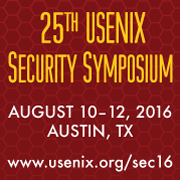
Get more
Help Promote graphics!
Securing Self-Virtualizing Ethernet Devices
Igor Smolyar, Muli Ben-Yehuda, and Dan Tsafrir, Technion—Israel Institute of Technology
Single root I/O virtualization (SRIOV) is a hardware/ software interface that allows devices to “self virtualize” and thereby remove the host from the critical I/O path. SRIOV thus brings near bare-metal performance to untrusted guest virtual machines (VMs) in public clouds, enterprise data centers, and high-performance computing setups. We identify a design flaw in current Ethernet SRIOV NIC deployments that enables untrusted VMs to completely control the throughput and latency of other, unrelated VMs. The attack exploits Ethernet ”pause” frames, which enable network flow control functionality. We experimentally launch the attack across several NIC models and find that it is effective and highly accurate, with substantial consequences if left unmitigated: (1) to be safe, NIC vendors will have to modify their NICs so as to filter pause frames originating from SRIOV instances; (2) in the meantime, administrators will have to either trust their VMs, or configure their switches to ignore pause frames, thus relinquishing flow control, which might severely degrade networking performance. We present the Virtualization-Aware Network Flow Controller (VANFC), a software-based SRIOV NIC prototype that overcomes the attack. VANFC filters pause frames from malicious virtual machines without any loss of performance, while keeping SRIOV and Ethernet flow control hardware/software interfaces intact.
Open Access Media
USENIX is committed to Open Access to the research presented at our events. Papers and proceedings are freely available to everyone once the event begins. Any video, audio, and/or slides that are posted after the event are also free and open to everyone. Support USENIX and our commitment to Open Access.
author = {Igor Smolyar and Muli Ben-Yehuda and Dan Tsafrir},
title = {Securing {Self-Virtualizing} Ethernet Devices},
booktitle = {24th USENIX Security Symposium (USENIX Security 15)},
year = {2015},
isbn = {978-1-939133-11-3},
address = {Washington, D.C.},
pages = {335--350},
url = {https://www.usenix.org/conference/usenixsecurity15/technical-sessions/presentation/smolyar},
publisher = {USENIX Association},
month = aug
}


















connect with us